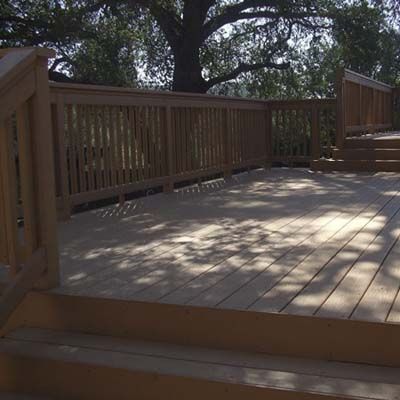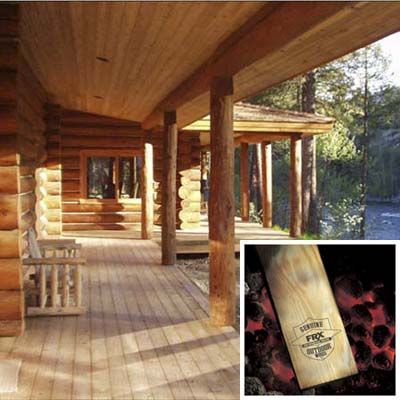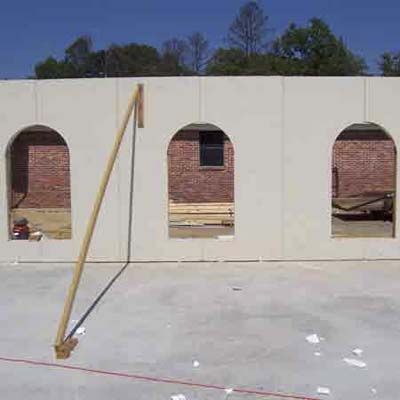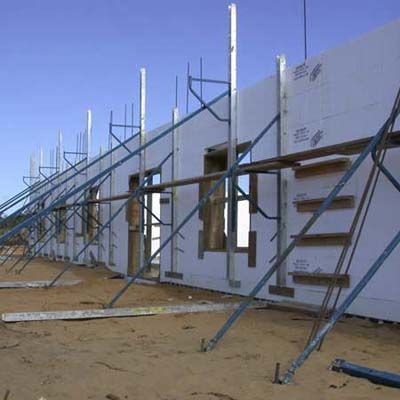Fire safety should be a major concern for all homeowners—and outdoor structures like decks can be particularly vulnerable. With the right materials and building techniques, you can reduce the risk of fire spreading from your deck to your home. In this guide, we’ll explore fire-resistant decking and framing options to help you create a safer outdoor living space.
Understanding Fire Resistance in Outdoor Structures
Certain materials are more flammable than others, and decks are often your home’s first point of contact for windblown embers or accidental flame-ups. By choosing fire-resistant materials and designs, you can create a protective barrier that helps safeguard your home from spreading fire.
The most common rating system used in the United States is the ASTM E84 test, which measures flame spread and smoke development. Fire resistance is measured by the following classes:
- Class I/Class A: Flame spread rating from 0–25
- Class II/Class B: Flame spread rating from 26–75
- Class III/Class C: Flame spread rating from 76–200
Deck materials are often rated on this scale. When choosing materials for your deck or framing, consider these ratings alongside other factors such as durability, cost, and aesthetics.
Types of Fire-Resistant Decking Materials
There are several fire-resistant decking materials available, each with different benefits and considerations. Let’s explore some of the most popular and effective options.
Composite Boards
Composite decking is popular due to its durability and low maintenance requirements. Many composite decking products also offer excellent fire resistance.
Composite boards often cost more upfront, but their longevity and fire-resistant properties make them worthwhile investments. They’re also available in various colors and textures, allowing you to get the look you want without compromising on safety.

Pressure-Treated Wood
For those who prefer the traditional look and feel of wood, pressure-treated lumber is an affordable and fire-resistant option. Wood treated with flame-retardant chemicals can achieve impressive fire resistance ratings, though it requires more maintenance than composite materials.

Other Innovative Options
Beyond composite and pressure-treated wood, there are other innovative fire-resistant decking materials worth considering. These include the following:
- Aluminum decking: Naturally fire-resistant and non-combustible
- PVC decking: Some brands offer high fire resistance ratings
- Concrete pavers: A great option for ground-level decks or patios
Each of these materials has its own set of pros and cons, so it’s important to weigh factors such as cost, maintenance requirements, and appearance alongside fire resistance.
Choosing the Right Fire-Resistant Framing Materials
The framing supporting your deck is equally important for fire resistance. Here are some fire-resistant framing options to consider for your project.
Fire-Retardant Treated (FRT) Wood
Fire-retardant treated (FRT) wood is a popular choice for fire-resistant framing. This material is traditional lumber that has been treated with fire-retardant chemicals to improve its fire resistance.
For example, FRX fire retardant has a Class A rating. Lumber treated with this fire retardant is an affordable alternative to other non-combustible framing materials and is particularly useful for areas vulnerable to windblown embers, such as eaves and the underside of decks.
While FRT wood costs more than untreated lumber, its fire-resistant properties make it a worthwhile investment for many homeowners. Remember that FRT wood may have slightly different structural properties than untreated wood, so always consult a professional when using it for load-bearing applications.

Structural Insulated Panels (SIPs)
Structural insulated panels (SIPs) offer excellent fire resistance and other benefits. These prefabricated panels consist of a foam core sandwiched between two layers of structural sheathing—typically oriented strand board (OSB) or plywood.
Some manufacturers offer SIPs with fiber cement sheathing on both sides, providing the highest fire rating along with incredible strength and resistance to mold and water damage. While more expensive than traditional framing methods, SIPs can offer superior insulation and faster construction times.

Insulated Concrete Forms (ICFs)
For the ultimate in fire resistance, consider insulated concrete forms (ICFs). These are essentially polystyrene molds filled with concrete, creating walls that can withstand flames for up to three hours longer than conventional lumber framing.
Some ICF manufacturers are enhancing their products’ fire resistance even further by adding flame-retardant chemicals to the polystyrene molds. While frequently used for basement or foundation walls, ICFs can be excellent for ground-level decks or patios in high-risk fire areas.

Building a Fire-Resistant Deck: Step-by-Step Guide
Creating a fire-resistant deck involves more than just choosing the right materials. Here’s a basic step-by-step guide to help you build a safer outdoor structure:
- Check local building codes and obtain necessary permits.
- Design your deck with fire safety in mind, including proper spacing and ventilation.
- Choose fire-resistant decking and framing materials based on your needs and budget.
- Prepare the site, ensuring proper drainage and clearance from combustible materials.
- Install the fire-resistant framing, following manufacturer guidelines and local codes.
- Add any necessary fire blocks or draft stops as required by local regulations.
- Install the fire-resistant decking material according to manufacturer instructions.
- Apply fire-resistant sealants or coatings if recommended by material manufacturers.
- Install fire-resistant railings and additional features like stairs or built-in seating.
- Have the completed deck inspected to ensure compliance with local fire safety codes.
Remember, while this guide provides a general overview, deck construction can be complex. If you’re not confident in your do-it-yourself (DIY) skills, hire a professional contractor experienced in fire-resistant construction techniques.
Fire-Resistant Coatings and Treatments for Existing Structures
If you have an existing deck you’d like to make more fire-resistant, you can likely add coatings and treatments to enhance its fire-resistant properties. Intumescent coatings are one popular option. These special paints expand when exposed to heat, creating an insulating layer that protects the underlying material from fire. They’re available for both wood and metal surfaces.
Penetrating fire-retardant treatments are also available for wood decks. These products soak into the wood fibers, making them more resistant to ignition and flame spread. These treatments may need to be reapplied periodically to maintain their effectiveness.
Before applying any fire-resistant coating or treatment, thoroughly clean and prepare the surface according to the product instructions. Some products may also require professional application for best results.
Incorporating Fire Pits Safely Into Deck Designs
Many homeowners enjoy the ambiance of a fire pit on their deck, but this can present additional fire safety challenges. With proper planning and precautions, you can safely incorporate a fire pit into your deck design.
First, ensure your deck is built with fire-resistant materials. Next, create a noncombustible zone around the fire pit. This can be achieved by using fire-resistant decking materials in a wider area around the pit or by installing a fire-resistant mat or pad.
When choosing a fire pit, opt for models designed specifically for deck use. These often have features like heat shields to protect the decking surface. Always follow the manufacturer’s guidelines for installation and use.
Maintain a safe distance between the fire pit and any combustible materials, including furniture, railings, and the sides of your house. Keep a fire extinguisher easily accessible, and never leave a fire unattended.
Maintenance Tips for Fire-Resistant Decking and Framing
Proper maintenance is key to ensuring your fire-resistant deck continues to perform as intended. Here are some tips to keep your deck in top condition:
- Regularly inspect your deck for signs of wear, damage, or decay.
- Keep the deck surface clean and free from debris, which can be potential fuel for fires.
- Reapply fire-resistant sealants or treatments as recommended by the manufacturer.
- Trim nearby vegetation to maintain a safe distance from your deck.
- Check and tighten any loose fasteners or connectors.
- Repair or replace any damaged decking or framing materials promptly.
- Keep the area under your deck clear of combustible materials.
- If you have a wood deck, consider professional cleaning and resealing every few years.
Cost Considerations for Fire-Resistant Materials
While fire-resistant materials often cost more upfront, it’s important to consider their long-term value. Not only do they offer enhanced safety, but many fire-resistant materials have superior durability and lower maintenance requirements.
For example, installing a composite deck typically costs between $25 and $54 per square foot, while most pressure-treated wood deck installations cost anywhere from $15–$25, according to Angi. However, composite decking requires less maintenance and can last significantly longer.
When budgeting for your fire-resistant deck, factor in not just the material costs but also any specialized installation requirements, ongoing maintenance needs, and potential savings on insurance premiums.
Building Codes and Regulations for Fire-Resistant Structures
Building codes and regulations regarding fire-resistant structures vary by location. Check with your local building department for specific requirements in your area.
Some common regulations you might encounter include the following:
- Minimum fire ratings for decking and framing materials
- Required clearances between decks and ground vegetation
- Specifications for enclosed areas under elevated decks
- Requirements for fire blocking in deck framing
- Regulations on the use of fire pits or other heat sources on decks
Always ensure your deck design and materials comply with local codes before beginning construction. Working with a licensed contractor familiar with local regulations can help ensure your project meets all necessary requirements.
Our Conclusion
Fire-resistant decking and framing materials offer an important layer of protection for your home—especially in areas prone to wildfires. While they may come with a higher initial cost, we believe the long-term safety and insurance benefits make them a worthwhile investment for many homeowners.
Before installing a deck, consider factors such as local building codes, environmental impact, and ongoing maintenance requirements. Whether you opt for composite decking, fire-retardant treated wood, or innovative options like aluminum or concrete, prioritizing fire resistance can provide invaluable peace of mind and protection for your home.
